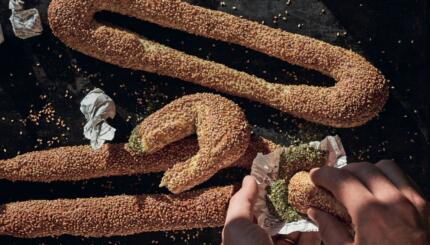There’s one thing that’s clear about Green goddess dressing: People love it.
Since its introduction in the early 1920s (more on that later), Green goddess dressing has amassed a hearty fan base that has sustained its popularity for more than a century. Manufacturer Seven Seas produced the first bottled version in the early 1970s and today, virtually every supermarket in America features at least one variety.
What is more opaque — and sometimes downright confusing — about Green goddess dressing, as many culinary historians have noted, are the cast of characters (literally) and the circumstances surrounding its origins, particularly the Jewish valences.
In 1923, Chef Roemer of San Francisco’s renowned Palace Hotel created a light Kelly green salad dressing in part as an edible homage to the actor Gorge Arliss and his hit play “The Green Goddess,” which had debuted two years prior on Broadway. Comprising scallions, parsley, tarragon, chives, mayonnaise, anchovies and vinegar, the dressing was piquant, herbaceous and rich — a perfect complement to fresh greens, and unsurprisingly, immediately very successful. Technically, the dressing was not entirely de novo, as critics then and now marked its similarities to a green French sauce dating back to the court of Louis XIII. While King Louis enjoyed his sauce over eel, Palace Hotel guests were initially introduced to Green goddess dressing as a garnish for canned artichokes.
The Nosher celebrates the traditions and recipes that have brought Jews together for centuries. Donate today to keep The Nosher's stories and recipes accessible to all.
Today, you can still order a salad (or a steak, or anything for that matter) garnished with a heavy ladle of Green goddess dressing at the Palace Hotel.
“As San Francisco’s premier dining venue for 115 years, the historic Garden Court at the Palace Hotel holds the proud distinction of being the birthplace of the original Green goddess dressing,” states Executive Chef David Teig. “The Garden Court received great acclaim when the dressing was introduced 101 years ago, and we are proud to continue the restaurant’s legacy and the famed dressing with creative dishes and flavors.”
However, if you want the “official” Palace Hotel recipe, well, that’s where the guessing game begins, for if you ask Chef Teig about the exact proportions of ingredients, he politely demurs. Devoted to the dressing? Don’t despair. The internet abounds with recipes, with some derivations including basil or avocado, so you don’t have to be a domestic — let alone a green — goddess to make your own.
While you’re mixing up your own version, let some other facts about Green goddess dressing marinate:
Like many food histories, the aforementioned origin story behind Green goddess dressing gets weirder in the details. First, there’s its namesake theatrical production. The rough plot of “The Green Goddess” is a Western exoticist fantasy, set in a fantastical Indian setting with the very white George Orliss starring as the Raja of Rukh. And the follow-up silent (1923) and talkie (1930) films got even worse, with Arliss reprising his role flanked by a coterie of more white actors sporting outrageous hairdos screaming in fake accents. In both the stage and the film adaptations, the proverbial Green Goddessing, by the way, is a completely fabricated deity, born solely out of the whims of the misguided racist playwright.
But buckle up, it gets crazier — and with a Jewish twist. Arliss was hardly a one-hit wonder when it came to leaning hard on ethnic stereotypes for dramaturgical purposes. Though he himself was not a member of the tribe, Arliss got his jollies (and commanded handsome pay checks) by regularly playing the parts of Jewish characters: in a London production of “Oliver Twist,” to rave reviews over his portrayal of Shylock and on to the titular role in “Disraeli,” a film biopic about the Jewish British writer and politician first in 1921, and then again in the “talkie” edition in 1929.
The latter performance garnered him an Oscar and seemingly gave him the proverbial green light to keep playing Jews on the silver screen, because yet again, in 1934, Arliss literally doubled down on the Jewish portrayals, playing both the father Mayer Rothschild and his son Nathan in “The House of Rothschild” (1934). Although the film in many ways was a pre-war rebuttal against anti-semitism, as film critic Eric A. Goldman aptly summarizes, the plotline reflects many pre-war stereotypical conceptualizations about Jews:
“If one watches early segments of the elder Rothschild fidgeting with coins and figuring out how to avoid paying taxes, you are made to feel uneasy, just as you might when watching some productions of Shakespeare’s “The Merchant of Venice.” A Jewish money-lender is rarely a character of choice for Jews, but the reality was that Jews were indeed money-lenders.”
Arliss was hardly the only non-Jewish professional actor cast in Jewish roles, as this practice was unfortunately all too common in the early days of Hollywood. And while the roots of Green goddess dressing may understandably make it less palatable, perhaps take some small comfort in this final bit of kismet: Arliss, whose oeuvre inspired one of the most celebrated salad dressings, was himself a life-long vegetarian, often averring, “I eat nothing I can pat.”



